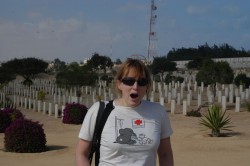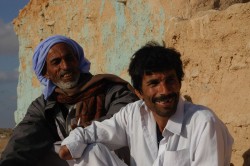Thu 29 Dec 2005
Day 3: Al Alamein battlefield
Posted by Mary under Egypt
No Comments
 This morning I left Cairo together with Ayman, the local campaign contact for ICBL, and we headed off to the Western Desert by rental car. The road to Alexandria and then along the coast to Libya is straight and bordered by desert on both sides making for some fast driving, but Ayman managed to get 2 speeding tickets within 30 minutes…
This morning I left Cairo together with Ayman, the local campaign contact for ICBL, and we headed off to the Western Desert by rental car. The road to Alexandria and then along the coast to Libya is straight and bordered by desert on both sides making for some fast driving, but Ayman managed to get 2 speeding tickets within 30 minutes…
We stopped first in Al Alamein, site of one of the fiercest battles of World War II. In the commmonwealth cemetary I filmed and photographed soldiers’ graves, walking first straight up to the ones from New Zealand without even realizing where I was. My grandfather’s brother Uncle Pat fought at Al Alamein and was injured badly on the right side of his body when the soldier beside him was blown up by a mine. I only learned this after he died in 1986.

Upon returning to New Zealand, great uncle Pat opened a catering company together with my grandfather that they named Maadi Caterers after the location of his camp outside Cairo where he had worked in the kitchen. His experience and the pyramids logo on the company letterhead had always interested me, so it was nice to finally see the place. We were the only visitors and after then noise of Cairo, the cemetary with his beautiful plants and trees was quite calming.
We stopped by El Alamein’s War Museum checking out all the exhibits on the various countries that fought in the war including the UK (incl. Australia & NZ) and on the other side of the trenches Italy and Germany. Egypt was occupied by the UK as a colonial power at that point meaning Egyptians also fought. Before leaving El Alamein we made one last stop at the Italian cemetary, a tall white tower filled small named boxes containing the remains of the Italians who had fought. Being Italian it was a beautiful building inside with a dome, a huge cross, a view of the Mediterranean Sea and incredible acoustics.
We continued the drive west along the coast passing dozens of minibuses loaded with suitcases of goods purchased in Libya for resale in Egypt. We stopped at Dabaa, met Ayman’s local contact Saber and climbed into his Toyota Hilux pick-up truck to go inland and meet a man who was nearly killed 12 months ago by an unexploded ordnance. His village was dirt poor – no roads, no electricity, no running water, and minimal housing. The victim Helal was injured in December 2004 as he grazed his sheep and goats nearby in the desert. His brothers demonstrated how he had made a fire on the ground that lit whatever WWII ordnance was buried underneath the sand. He had lost his hand, damaged his eyesight, badly damaged both both legs, and had horrible scars all over his stomach.
Helal’s three sons, aged 2, 3, and 4 years ran around, as he walked over to the well to show how he couldn’t pull up the bucket or help with minimal tasks for the household. He had received 6 months of medical treatment at Alexandria hospital, but this was too far away to return for physical rehabilitation. As we drank tea and I filmed, the family told us about some ordnance that had been recovered from a field in preparation for planting. One of his brothers offered to take us.

We drove and then walked a narrow path follow each other’s footsteps until we reached the field. To the side was avery big air dropped bomb that had never detonated. It was as tall as my legs and round. We took photos and filmed and after praying nearby Saber explained that the Atmy would remove the bomb or someone reported it, but the communities in the area are poor and reluctant to contact authorities. They have no access to telephones either, but all our mobiles worked well out in the desert so I conideredd calling the UN mine action service in New York to get them to take it away! After driving for another hour, Ayman and I made it to the regional capital of Matrouh and checked into a hotel by the main square.



No Responses to “ Day 3: Al Alamein battlefield ”